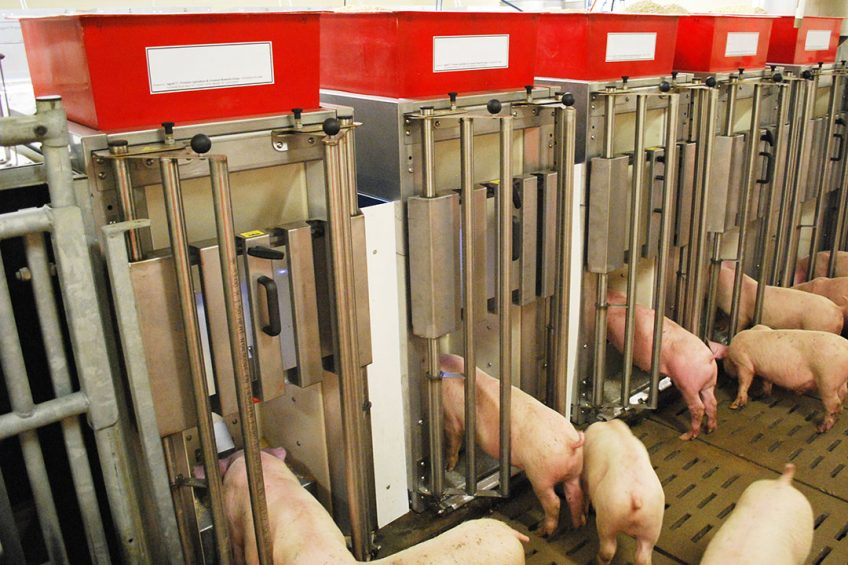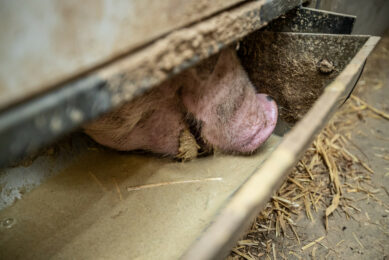Sustainability through precision swine feeding

In pork production, environmental impact is mainly centred on the excretion of excess nitrogen and phosphorus from feed. Through precision feeding, pigs can retain significantly more of the nitrogen found in the protein in their feed, and therefore excrete much less than pigs reared in conventional group phase feeding programmes.
Several years ago, a team of scientists from Brazil and Canada examined how much general environmental impact might be decreased in Brazilian swine production by switching from conventional feeding to one of 2 precision swine feeding systems during in grow-finish production.
These 2 systems were:
- ‘Precision daily feeding by group’ (PFG, where the whole herd is fed the same diet, adjusted each day) and
- ‘Precision daily feeding by individual’ (PFI, where the diet of each pig is adjusted every day to meet each pig’s nutritional requirements).
Overall, the scientists found that compared with conventional feeding, both precision feeding systems reduced potential environmental impact; they concluded that precision feeding is “clearly” an effective approach for improving the environmental sustainability of Brazilian pig production.
Nutrient excretion
Last year, one of the same scientists, Dr Candido Pomar, published a study called Precision pig feeding: a breakthrough toward sustainability with Dr Aline Remus, both scientists at Agriculture and Agri-Food Canada’s Sherbrooke Research and Development Centre in Quebec.
In this study, they note that livestock animals are generally quite inefficient in transforming nutrients in feed into food products (meat). In growing pigs, only 15 to 33% of protein (nitrogen), usually the most expensive component of feed, is retained. The rest of the N is excreted through urine, faeces and digestive gas.
To make matters worse, because pig farmers want to make sure the requirements of the most demanding animals in the herd are satisfied, many pigs in the herd receive more nutrients than they need. In addition, to account for variability in feed efficiency among pigs, potential individual health challenges and other factors, safety margins are included when formulating diets in order to achieve the best group performance. These practices cause many pigs to therefore receive too much protein and excrete the excess N. Figure 1* shows how much of one amino acid, lysine, is typically given in the three phases of conventional feeding over time (solid line). This is a great deal more than pigs require; the orange line indicates the pigs’ actual daily requirements (MP100).
Figure 1 – Dietary lysine levels for pigs in a three-phase feeding programme (3P) or in a daily-phase feeding programmes provided individually to meet 110% (MP110), 100% (MP100), 90% (MP90) or 80% (MP80) of the nutritional requirements estimated daily throughout the trial.

To try and solve this – and to address the fact that nutrient requirements of growing pigs change over time – the conventional 3-phase feeding regimen was created. In this scenario, one feed is provided at first, another for the middle growth phase and a third for the period approaching finish. While this practice does provide better matching of the nutrients in feed to the needs of pigs as they age, the problems of excess N excretion remain.
However, if diets can be adjusted on a daily basis for the entire herd or preferably for each individual pig, much more closely matching feed components and amount of feed to the animals’ requirements, efficiency of nutrient utilisation can be greatly increased. With PFI, achievable N retention can, astonishingly, reach more than double (70%), says Remus, of conventional three-phase feeding, which at its best can only achieve a little over 30%.
Precision feeding also reduces the number of feeds from 3 to 2, simplifying feed management. “In addition, it saves producers money because it cuts down on the crude protein content in feed, reduces feed wastage and provides lots of opportunity to use inexpensive by-products such as oat hulls,” says Remus. “Using by-products of crop production or human food product manufacture is a very sustainable practice.”
It is clear that continuous and automatic monitoring of animals and farm resources through precision feeding systems can support better production decisions at the farm level.”
The basics of precision feeding
Precision feeding on a commercial farm requires at least two different feeds, formulated with different levels of net energy, standardised ileal digestible amino acids and other essential nutrients. One of the feeds, which we can call ‘A,’ is highly nutrient-dense, formulated to meet the requirements of the most-demanding pigs at the beginning of the growing period. The other, B, is lower in nutrient density and meets the complete needs of a less-demanding pig at the end of the finishing period.
Precision feeding also require a feeding system that automatically blend the 2 feeds – either blended differently every day or 2 to meet the average, but changing, nutritional requirements of the group (PFG), or blended differently over time for each individual pig (PFI) to very accurately meet each animal’s needs. Also in both cases, a way to measure the weight of each pig is needed.
Obviously for PFI, a way to distinguish between pigs is required. Plastic button tags inserted in the ear can contain passive identification transponders (RFID) recognised by the precision feeding system when each pig puts its head into the trough.
With either PFG or PFI, one custom-blended serving is instantly created and delivered. There’s a time lag to ensure that the pig eats the entire serving before it receives a new serving. “Serving size is progressively increased and ranges between 15 and 25g,” says Remus. “Feed density needs to be measured weekly and this information should be used to convert feed volumes to feed weights.”
Costs and return on investment
The costs of a precision feeding system for swine include the cost of the feeding system, RFID tags, and a way to measure weight. Remus explains that scales are not needed, because “a system of very low-tech cameras and software can estimate the weight of a pig by its size. The main cost of precision feeding is the feeder itself, but we are expecting them to be similar in price to existing commercial feeders when they are launched onto the market.”
Cost savings come from making 2 feeds (instead of 3 feeds for 3-phase feeding) and feeding less crude protein, from decreased feed waste and the possible incorporation of by-products. “We often associate using by-products with loss in performance,” Remus said. “It is true that in conventional feeding, to prevent any performance loss, you need to slowly increase the amount of the by-product over time so that the pigs adapt. However, in precision feeding, whether PFG or PFI, the by-products are given all the way along, in a very low percentage to start. With oat hulls for example, they would make up a maximum of 15% in a B diet, and some pigs at the start would receive a blend of 20% B diet and 80% A diet, but at finishing most pigs are receiving 80%of B diet, and their performance is not affected at any point.”
In addition to its strong sustainability benefits, Remus has determined that PFI can provide savings of CAD$ 8 to $ 15 (USD $ 6 to $ 11) per pig, which makes return-on-investment (ROI) quite rapid. In terms of when PFI feeders will be commercially available, she expects this within 5 years. Remus notes that PFI is being explored in Europe, including in the Feed-a-gene project in Italy. Regarding PFG, Remus knows of one system that is already commercially available, the Gestal Evo from JYGA Tech. However, Remus notes that whilst PFG is more accurate in terms of meeting the nutrient requirements of the herd compared to three-phase feeding (and therefore is more sustainable with less N excretion into the environment) and saves costs compared to three-phase feeding, PFI is even more accurate, sustainable and cheaper.
More than sustainability and cost savings
However, beyond sustainability and lower costs, PFI is going to provide pig producers with exciting additional benefits, namely increased lean gain (versus lean and fat gain) and the ability to provide much-improved herd health management.
That is, a system of simple cameras and software in a pig barn, along with data from the precision feeder, can provide a wealth of information that can be used to adjust the carcass composition of individual pigs and to address individual health issues much more quickly than in conventional farming systems.
This is done through the development of mathematical models. “In the experimental setup, we use x-ray technology to measure protein deposition over time, and measure weight gain at the same time, and then correlate the 2 in an equation,” Remus explains. “Protein deposition matters because not only do we want pigs to grow quickly but we want them to be efficient in creating muscle, in lean gain. We want to have nutrient utilisation be as fast as possible, to go into as much lean gain as possible, to reduce costs and maximise sustainability, to get the most value possible from feed. PFI makes this possible.”
How much, however, do genetic differences matter? Remus says that there is much to be learned about this. “There is variability in protein deposition and many other metabolic processes even within litters with the same parents, so one of the things we are working on is understanding why protein deposition varies in pigs with the same genetic background and provided the same feed. It’s a matter of identifying genetic markers.”
Improving herd health management
Remus is even more excited about how precision feeding can improve individual and herd health management. “With software and cameras – the software being capable of identifying each pig through physical characteristics – we can follow each pig’s behaviour and feeding pattern of the pig, and detect illness a day or 2 before other symptoms start,” she explains. “The first sign of illness is not eating as much. So, we can therefore treat that pig earlier, isolate it for better care and prevent disease spread as well, all of which is better for the pigs and reduces costs. Software trained to identify individual pigs has already been developed at University of Nebraska and they’ve followed activity levels (energy expenditure). The relationship between activity and differences in carcass composition may be explored, but the biggest potential I see is with disease detection.”
Looking forward, Remus and Pomar both believe that further understanding of metabolism and nutrition at the individual pig level will allow animal science to progress, opening up new opportunities for individualised nutrition. “It is clear that continuous and automatic monitoring of animals and farm resources through precision feeding systems can support better production decisions at the farm level,” Remus says, “ultimately enhancing farm profitability, efficiency, and sustainability of the overall production system.”
* Reproduced from the study ‘Precision feeding can significantly reduce lysine intake and nitrogen excretion without compromising the performance of growing pigs’ in the journal ‘Animal.’






